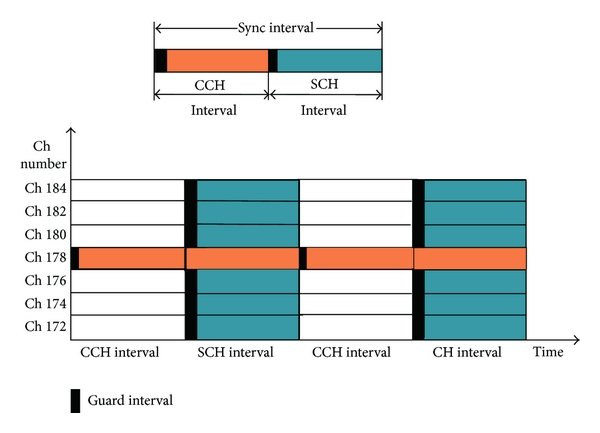Latency is very crucial in VANETs due to the short time needed by a perilous safety application. As discussed in my second blog on WAVE system Architecture and MAC Layer: IEEE802.11p, IEEE 1609.4 postulates extensions to the IEEE 802.11p MAC for multichannel operations that are needed against single channel to curb the problems. In WAVE architecture, we have two types of channels:
- Control channel (CCH)
- Service channel (SCH)
Figure 8 depicts the distribution of these channels in 75 MHz Band allotted by FCC.
![Figure 8: The set of channels defined in the WAVE trial standard [2]](https://apoorvsaxena4.wordpress.com/wp-content/uploads/2015/06/channels.jpg?w=748&h=193)
In CCH i.e. control channel, messages related to safety and control are exchanged between devices while messages related to non-safety application services are exchanged in SCHs. As per the scheme formulated, individually each device should alternate between these two channels. The time during which a device stay tuned to these channels are known as CCH and SCH intervals, respectively. Both intervals are set to a fixed value (i.e., 50 ms) in the WAVE standard [2].
Recently, many committees and institutes from different part of the world have examined the performance of these channels against single channel and confirmed that the fixed-length CCH/SCH intervals cannot be operative for vigorously varying traffic load. In an overcrowded vehicular traffic state, the CCH with fixed length is not able to handle a huge sum of safety packets and control packets. Along with this in light networks, CCH channel actually remains unexploited due to rare transmissions from vehicles. Applications like video download and map update, that consumes large amount of bandwidth, cannot get sufficient SCH resources due to extreme contention. Thus, many protocols have been planned and formulated to deal the dynamic fine-tuning of CCH/SCH intervals.
Just like Figure 8, Figure 9 depicts the complete multi-channel operation in IEEE 802.11p.

GI explains the scenario for the radio switching delay and the time synchronization error. Generally the standard value for the GI are between 4 and 6 ms. Throughout the GI, nodes are not permitted to send or receive data packets.
If we have two devices who want to have exchange of data, hey should be tuned on same channel, for transfer to occur time synchronization is quite necessary. In order to ensure this, both the channel intervals are synced to an external time reference CUT/UTC i.e. Coordinated Universal Time often provided by GPS. Now if one of the device fails to get UTC from its local GPS, it can contact other nodes over the air in order to ensure it gets synced to other device. IEEE 802.11p specifies something called as WTA Frames (wave time advertisement). This channel switching scheme is known as an alternating access.
Other than altering scheme the standard has also specified three more such schemes:
- Continuous: Permits a node to always stay tuned to the CCH in order to exchange only safety-related information. Thus this scheme is not appropriate for nodes who are particularly interested in both safety and non-safety applications.
- Immediate: Allows nodes to start communications over the SCH immediately without waiting for the next SCH interval.
- Extended Access: In contrast to immediate scheme this scheme allows nodes to keep communicating over the SCH without switching to the CCH.
The same can be seen in Figure 10 shown below.
![Figure 10: 4 channel switching schemes [1].](https://apoorvsaxena4.wordpress.com/wp-content/uploads/2015/06/switching-scheme.jpg?w=748)
Together immediate and extended access schemes are basically intended to develop and improve the performance of applications like video streaming, map updates etc. that consumes extensive bandwidth. Nevertheless, these two schemes could be only favorable to those vehicles which are not interested in safety applications such as a ‘cooperative collision avoidance’. Thus among all the schemes described above what I feel is, the first scheme i.e. alternating access scheme is the best solution for supporting both safety and non-safety applications.
Thus in order to conclude the discussion on multichannel operation, it can be said that for proper channel utilization and increasing the capacity and performance of network under dense mobility environment multichannel operation using both CCH for safety and SCH for non-safety applications are needed. I have tried to explain their distribution, operation and application.
In my coming blog I will discussing about the challenges face by VANET and something about its socio economic impact and challenges. Till then enjoy reading and please comment below in-case you have any doubts or questions. Goodbye..!! J
References:
[1] Hongseok Yoo and Dongkyun Kim, “Dynamic Channel Coordination Schemes for IEEE 802.11p/1609 Vehicular Networks: A Survey”, Kyungpook National University, Daegu 702-701, Republic of Korea, Received 19 July 2013; Accepted 11 September 2013
[2] Lusheng Miao, Karim Djouani, Barend J. van Wyk and Yskandar Hamam, “A Survey of IEEE 802.11p MAC Protocol”, Cyber Journals: Multidisciplinary Journals in Science and Technology, Journal of Selected Areas in Telecommunications (JSAT), September Edition, 2011
Can the channels in 802.11p be aggregated? In other words, can I modify 802.11p protocol directly to add spectrum aggregation function?
LikeLike
Thanks for good explanation on control and service channels in 802.11p.
I have couple of queries
1. Does CCH/SCH intervals are standardized like beacon interval. How a node can convey CCH/SCH interval in any packet?
2. Does special HW required to support 802.11p or standard 802.11 HW with 11p sw stack enough?
3. CCH/SCH are broadcast/multicast packets?If yes how it guaranteed the successful transmission?
LikeLike